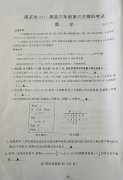2015南京三模英语试题答案(3)
I understand how disappointed you are that we were unable to offer you a space in our incoming class, I want to be honest with you and let you know that it’s very rare that we learn something that leads us to change our decision, in the last ten years we’ve about 500 requests for a review… and changed the decision four times
Wish you all the best~
XXX
56. Of the three letters, which is in response to which?
A. A---B B. C---B C. C---A D. B----C
57. Chances for Duke University to change its admission decision in history were_______.
A. none B. big C. slim D. hard to tell
58. What makes it impossible for the applicant to resubmit an application next year?
A. Tying the letter to an owl and send it to UCAS
B. Printing out grade sheet
C. Applying for the Liberal Arts course as an option
D. Improving his scores
59. What can we infer form the letter about college application?
A. It is disappointing for sure.
B. Rejection letters are better written than offers.
C. It is no as fun as on imagines.
D. There could be extra work beyond normal procedure.
B
Do I exist?
Obviously!
Until Descartes came along in the seventeenth century, everyone assumed that we exited. Obviously. The fact seemed so mind-blowingly obvious that it wasn’t really discussed. We could see ourselves in the mirror, we could feel pain and pleasure, we could think thoughts for ourselves and, more importantly, perhaps, all the world’s main religions assumed that we do exist. So we exist.
No you don’t it!
You don’t exist. That’s because it’s impossible to show once and for all that you do. There’s no proof. You might think you exist-that you are sitting at a table reading this book, for instance-but how could you show with 100 percent certainty that this is true? There’s no experiment that could prove it. Although Descartes said just you could prove your own existence by the fact that you are able to think, this isn’t actually, according to the British philosopher A. J. Ayer. Just because we know that we are thinking, this doesn’t mean that there is a “you” doing the thinking. It just shows that the thoughts are happening, not that anyone is having them. Thoughts exists, “You” don’t.
_____________!
What a waste of time this question is. Although you can argue until the end of time whether you exist or not, it doesn’t get you anywhere. Unless you forget about this unanswerable question, you’ll be stuck thinking about it forever, and that isn’t of any use to anyone. Move on. Think about something more important! This very roughly, is the view of almost all philosophers, who prefer to answer other, apparently more useful, questions.
Yes, but…
You exist, but not in the way you might think. According to the great French philosopher Ren Descartes, you can’t show that anything exists—apart from your own self. The existence of the entire world can be doubted in one way or another, but the facts you’re having thoughts shows that there might be something (that’s you) having them. This let Descartes to write the famous philosophical phrase, “ I think before I am”.
60. Which of the following can be the missing heading?
A. Forget about it B. What a ridiculous point
C. Think about it D. What a pointless question
61. This passage is anything but a(n)___________.
A. comment B. discussion C. argument D. debate
62. The famous answer to the question “Do I exist?” is ___________.
A. No, you don’t exist. B. I think, therefore, I am.
C. Yes, you do exist. D. It won’t get you anywhere
C
Knots are the kind of stuff that even myths are made of.
In the Greek legend of the Gordian knot, for example, Alexander the Great used his sword to slice through a knot that had failed all previous attempts to unite it. Knots, enjoy a long history of tales and fanciful names such as “Englishman’s tie, ” “and “cat’s paw. ” Knots became the subject of serious scientific investigation when in the 1860s the English physicist William Thomson (known today as Lord Kelvin) proposed that atoms were in fact knotted tubes of ether(醚). In order to be able to develop the equivalent of a periodic table of the elements, Thomson had to be able to classify knots — find out which different knots were possible. This sparked a great interest in the mathematical theory of knots.
A mathematical knot looks very much like a familiar knot in a string, only with the string’s ends joined. In Thomson’s theory, knots could, in principle at least, model atoms of increasing complexity, such as the hydrogen, carbon, and oxygen atoms, respectively. For knots to be truly useful in a mathematical theory, however, mathematicians searched for some precise way of proving that what appeared to be different knots were really different — the couldn’t be transformed one into the other by some simple manipulation(操作). Towards the end of the nineteenth century, the Scottish mathematician Peter Guthrie Tait and the University of Nebraska professor Charles Newton Little published complete tables of knots with up to ten crossings. Unfortunately, by the time that this heroic effort was completed, Kelvin’s theory had already been totally discarded as a model for atomic structure. Nevertheless, even without any other application in sight, the mathematical interest in knot theory continued at that point for its own sake. In fact, mathematical became even more fascinated by knots. The only difference was that, as the British mathematician Sir Michael Atiyah has put it, “the study of knots became a special branch of pure mathematics. ”





